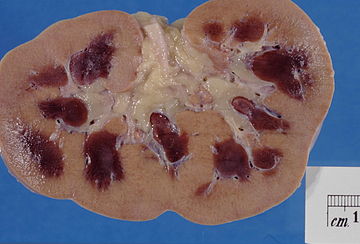Ho sabíeu?
Podeu fer doble clic en una paraula per a buscar-la a TermGallery.
Podeu fer doble clic en una paraula per a buscar-la a TermGallery.
Significats de acute kidney injury en anglès

Abrupt loss of kidney function that develops within 48 hours.
Termes relacionats
Sinònims
Examples for "aki"
Examples for "aki"
1
AKI is an important clinical problem that has become increasingly more common.
2
Discussion: Following major gastrointestinal surgery, AKI occurred in one in seven patients.
3
Regarding long-term outcomes, wild-type kidneys regenerated completely within 5 weeks after AKI.
4
Within this context, stem cells may provide a clinical approach for AKI.
5
This preoperative prognostic model identified patients at high risk of postoperative AKI.
1
Pence is summat similar to 'arf-crowns, and the day were very dark.
2
Those bloomin' 'Eadquarter blokes doesn't know what they're doin' 'arf the time.
3
Not a real one, but good enough to earn two and a 'arf.
4
I want change for arf a suvrin: ain't that straight, now?
5
Seeing I'd just drawn you in the sweepstike, of course, I listened-not'arf!
1
I did not know much about uremic poisoning.
2
I got uremic poisoning!
3
If it is due to stable miasma, uremic poisoning, pyemia, influenza, rheumatism, toxic agents, etc., they should receive prompt attention for their removal or mitigation.
4
Uremic poisoning and acidemia and coma of diabetes tray cause a pulse to be very slow.
5
"This is uremic poisoning," exclaimed the doctor as the smell of urine filled the room.
1
Summary: The prognosis is generally good for recovery after acute renal failure.
2
The incidence of stroke, acute renal failure and postoperative bleeding was comparable.
3
We describe a case of acute renal failure secondary to bilateral ureteral obstruction.
4
The first patient presented with nephrotic syndrome and acute renal failure.
5
Coma and acute renal failure emerged as independent predictors of mortality.
1
In the following days, the patient developed severe oliguric acute kidney failure.
2
She was an old female, euthanased after acute kidney failure.
3
Controls included healthy individuals, individuals after kidney donation and ICU patients with acute kidney failure.
4
The condition can result in acute kidney failure.
5
These include sudden death, acute kidney failure, respiratory failure, gastrointestinal bleeding, and bone marrow suppression in immunocompromised people.
Ús de acute kidney injury en anglès
1
Fifty-seven percent developed acute kidney injury during their intensive care unit stay.
2
Further development of QPI-1002 for prophylaxis of acute kidney injury is warranted.
3
The most common complication studied was the 30-day rate for acute kidney injury.
4
One patient suffered acute kidney injury that was successfully medically managed.
5
The use of amoxicillin or azithromycin was not associated with acute kidney injury.
6
Patients with acute kidney injury and prior renal transplant were excluded.
7
She was admitted three years back with acute kidney injury and skin rashes.
8
This study aimed to estimate the excess mortality attributable to acute kidney injury.
9
Progressive tubulointerstitial fibrosis may occur after acute kidney injury due to persistent inflammation.
10
Purpose: N-acetylcysteine may prevent acute kidney injury after cardiac surgery.
11
Five patients were reported to have developed acute kidney injury.
12
His laboratory tests showed that he had acute kidney injury and severe lactic acidosis.
13
Secondary outcomes included acute kidney injury and failure and treatment with renal replacement therapy.
14
Background: Case reports indicate that the use of fluoroquinolones may lead to acute kidney injury.
15
Introduction: Patients undergoing on-pump cardiac surgery are at an increased risk of acute kidney injury.
16
The magnitude of the impact of acute kidney injury on outcome, however, is still unclear.
Translations for acute kidney injury
portuguès

